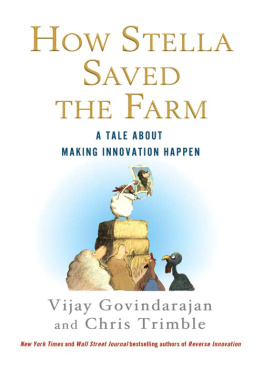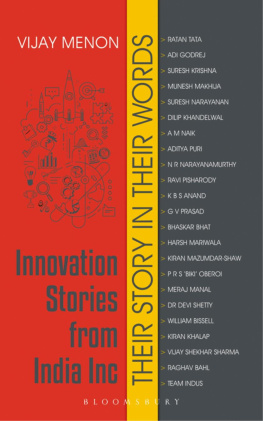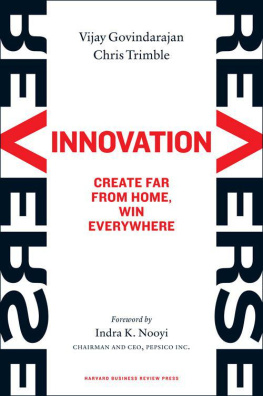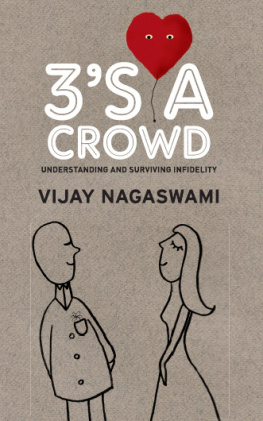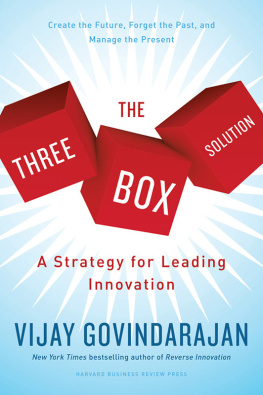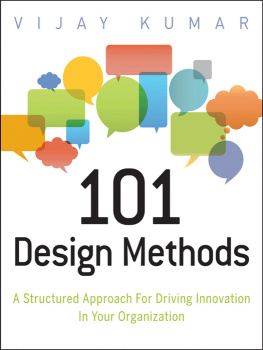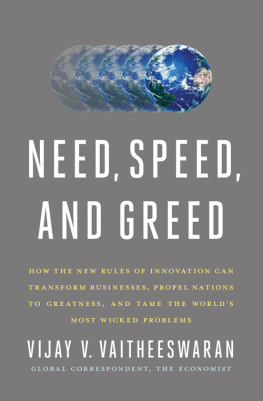Govindarajan Vijay - The Other Side of Innovation: Solving the Execution Challenge
Here you can read online Govindarajan Vijay - The Other Side of Innovation: Solving the Execution Challenge full text of the book (entire story) in english for free. Download pdf and epub, get meaning, cover and reviews about this ebook. year: 2010, publisher: Harvard Business School Press, genre: Business. Description of the work, (preface) as well as reviews are available. Best literature library LitArk.com created for fans of good reading and offers a wide selection of genres:
Romance novel
Science fiction
Adventure
Detective
Science
History
Home and family
Prose
Art
Politics
Computer
Non-fiction
Religion
Business
Children
Humor
Choose a favorite category and find really read worthwhile books. Enjoy immersion in the world of imagination, feel the emotions of the characters or learn something new for yourself, make an fascinating discovery.

- Book:The Other Side of Innovation: Solving the Execution Challenge
- Author:
- Publisher:Harvard Business School Press
- Genre:
- Year:2010
- Rating:4 / 5
- Favourites:Add to favourites
- Your mark:
- 80
- 1
- 2
- 3
- 4
- 5
The Other Side of Innovation: Solving the Execution Challenge: summary, description and annotation
We offer to read an annotation, description, summary or preface (depends on what the author of the book "The Other Side of Innovation: Solving the Execution Challenge" wrote himself). If you haven't found the necessary information about the book — write in the comments, we will try to find it.
The Other Side of Innovation: Solving the Execution Challenge — read online for free the complete book (whole text) full work
Below is the text of the book, divided by pages. System saving the place of the last page read, allows you to conveniently read the book "The Other Side of Innovation: Solving the Execution Challenge" online for free, without having to search again every time where you left off. Put a bookmark, and you can go to the page where you finished reading at any time.
Font size:
Interval:
Bookmark:
 Copyright Copyright 2010 Vijay Govindarajan and Chris Trimble Al rights reserved No part of this publication may be reproduced, stored in or introduced into a retrieval system, or transmitted, in any form, or by any means (electronic, mechanical, photocopying, recording, or otherwise), without the prior permission of the publisher. Requests for permission should be directed to permissions@hbsp.harvard.edu, or mailed to Permissions, Harvard Business School Publishing, 60 Harvard Way, Boston, Massachusetts 02163. First eBook Edition: September 2010 ISBN: 978-1-4221-6696-3 For Kirthi and Lisa Contents Copyright Preface
Copyright Copyright 2010 Vijay Govindarajan and Chris Trimble Al rights reserved No part of this publication may be reproduced, stored in or introduced into a retrieval system, or transmitted, in any form, or by any means (electronic, mechanical, photocopying, recording, or otherwise), without the prior permission of the publisher. Requests for permission should be directed to permissions@hbsp.harvard.edu, or mailed to Permissions, Harvard Business School Publishing, 60 Harvard Way, Boston, Massachusetts 02163. First eBook Edition: September 2010 ISBN: 978-1-4221-6696-3 For Kirthi and Lisa Contents Copyright Preface
Business organizations are not built for innovation; they are built for efficiency. The day-to-day pressures are enormous, and combining a discipline of efficiency with a discipline of innovation is just damned hard. One seasoned executive casual y asked us not long ago, Is innovation within an established organization even possible? We do not regard the questioner as a cynic. We respect the question. In fact, here is a brutal truth: our organizations today are only modestly more prepared for the chal enges of innovation than they were fifty years ago. We are hardly alone in this view.
Ray Stata, founder and chairman of Analog Devices, a $2 bil ion semiconductor manufacturer, is extremely thoughtful on the topic of innovation. About ten years ago, he said to us, The limits to innovation in large organizations have nothing to do with creativity and nothing to do with technology. They have everything to do with management capability.1 The statement seemed provocative to us at the time. Today, after a decade of rigorous research, it seems an obvious truth. Most companies have plenty of creativity and plenty of technology. What they lack are the managerial skil s to convert ideas into impact.
But how can this be? Todays global business leaders are smart and talented. Many are experienced innovators, veterans of the whiz-bang late 1990s when everyone seemed to have innovation on their minds 24/7. Most have col ected a few hard-won lessons learned. Nonetheless, there are limits to what executives can learn about innovation, even over an entire career. Innovations come in many shapes, sizes, and colors. They are context-specific.
Experience from one endeavor often has little or no relevance for the next. A ful perspective would require a career spanning multiple industries and multiple innovation types. Sadly, innovation initiatives are long and careers short. Seeking insight outside their own experiences, executives often look to icons of innovation like Apple. Many have wondered: What is Apples secret? What managerial magic led to the runaway success of the iPod? But in ten years of research, not one of the companies we have studied has claimed to have innovation al or even mostly figured out. This is not a matter of modesty.
In fact, these icons of innovation are usual y trying to answer the same questions, only by looking in the mirror. They are asking themselves: What exactly did we do that made our past innovation efforts a success? How can we make innovation more routine? This is what is currently happening, for example, at General Electric (GE). The company has a rich history of innovation successes, including breakthroughs in tungsten filaments for light bulbs, jet engines, and magnetic resonance imaging (MRI) devices for medical diagnostics. Nonetheless, GE faces the same difficulties we see everywhere and is now actively engaged in trying to figure out exactly what it has done when it has succeeded and how to reliably repeat it. That is current state of the practice of innovation, even in the worlds best companies. Nonetheless, we are highly optimistic.
The organization of the futurethe near futurewil be much more adept at simultaneously delivering efficiency and innovation. (If you are eager to learn exactly how, please skip to the introduction.) The Story of Management Research We are so strongly optimistic because we have seen that while there are sharp limits to how much practitioners can advance knowledge about managing innovation on their own, partnerships between business and academia can be very powerful. And management research has only recently advanced to the point that a significant breakthrough is possible. Believe it or not, until recently, scholars have not aggressively advanced the field of innovation. Given the number of business schools around the world engaged in management research, this is surprising to many. It is less so when put in historical context.
The story of ideas about management begins at roughly the start of the twentieth century, around the time that the first business schools were founded. Back then, management thinking was rooted in experiences in factories, railroads, and assembly lines. People and organizations were viewed as mere components in the machinery of production. Progress in advancing knowledge about management was slow through the first half of the twentieth century, in part because business schools viewed themselves primarily as trade schools, not research institutions. By the middle of the century, however, leading thinkers had at least acknowledged that people are different from tools and that organizations are more like organisms than machines. (Physicists were advancing their field somewhat more rapidly.
By then, they had developed the theory of relativity and cracked the secrets of the atom.) In the latter half of the century, business schools expanded their charters. They dedicated themselves to advancing knowledge about management through rigorous academic research. Many business concepts that today seem basic and mainstream originated from this new commitment and, thus, are newer than many people realize. It wasnt until the 1970s, for example, that senior executives widely accepted that their number one job was a newfangled thing cal ed
Next pageFont size:
Interval:
Bookmark:
Similar books «The Other Side of Innovation: Solving the Execution Challenge»
Look at similar books to The Other Side of Innovation: Solving the Execution Challenge. We have selected literature similar in name and meaning in the hope of providing readers with more options to find new, interesting, not yet read works.
Discussion, reviews of the book The Other Side of Innovation: Solving the Execution Challenge and just readers' own opinions. Leave your comments, write what you think about the work, its meaning or the main characters. Specify what exactly you liked and what you didn't like, and why you think so.

